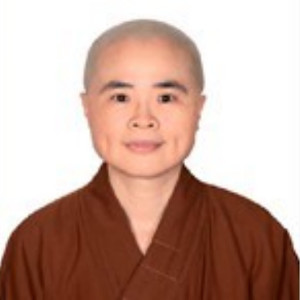
Bhikkhuni Tsung-Teung
Taiwan
Bhikkhuni Tsung-Teung
Taiwan
Bhikkhuni Tsung-Tueng writes: “The two things in this life which I accomplished and am proud of are: first and foremost, I took up the robes when I was nineteen (1982) and received my Bhikkhuni precepts two years later. Second, I engaged in spiritual care for terminally ill patients and developed a hospice care profession in Buddhism from the aspects of clinical service, teaching, and research.”
Bhikkhuni Tsung-Tueng is an early pioneer in mainstreaming Hospice-palliative care in Taiwan, and developing a Buddhist model of care. Her journey began at the palliative ward of National Taiwan University Hospital where she began to work with Professor Qing-Yu on a research project entrusted by the Buddhist Lotus Hospice Foundation to integrate Buddha Dharma and medicine. They were on the frontline caring for terminally ill patients and assessing their spiritual needs. Then returned to their research team to discuss care plans. The approach worked and by the third year onwards, they began to train clinical Buddhist Chaplains.
Thereafter, Bhikkhuni Tsung-Teung travelled internationally to present papers in various countries: Malaysia, Japan, India, and Rome, and she co-authored, The Mystery of Life and Death: 16 Spiritual Dialogues and End-of-Life Learning in 2016, the first care-guideline book that combines Dharma with clinical applications: https://www.books.com.tw/products/0010734961
Bhikkhuni Tsung-Tueng produced the documentary film, Review in 2021.
https://www.youtube.com/watch?v=uQtdGMAHpao
Supervised and produced Listen to the Inner Voice in 2018.
https://www.youtube.com/watch?v=9_tdEyBGtcw
Participated in filming Meeting You at the Turning Point of Life in 2014.
https://www.youtube.com/watch?v=6Foy--Q-wQ4
And participated in the lead role of The Lotus Blossom-Clinical Buddhist Monastics Practicing in Hospital Sites in 2011.
https://www.youtube.com/watch?v=Bh8oCJ3uhKY&list=PL5AE4789088B39FBB&index=2
Bhikkhuni Tsung-Tueng writes: “After 24 years of commitment to the front line of clinical care on the scene of life and death, I have faced different subjects and various challenges daily: dying patients, family members, monastics who have just begun their clinical practice, dialogues from cross-field professionals and inter-religious dialogues. All the experiences are helping me deepen my practice of Buddha Dharma.
I am grateful for such causes and conditions. I hope that in my lifetime, I can continue to establish a more complete teaching system in applying the Buddha Dharma to clinical care, so as to benefit future generations.”